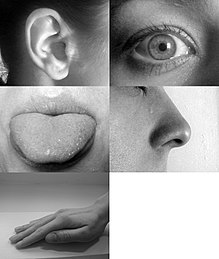User:Jordanyesong/sandbox
Food is a multi-sensorial experience in which all five senses (vision, touch, sound, smell and taste)[1] come together to create a strong memory. [2]
In food marketing, the goal of the marketers is to design their products so that they would stimulate as many senses of the customers.
At restaurants, many sensorial aspects such as the interior design (vision), texture of the chairs and tables (touch), background music and the noise level (sound), openness of the kitchen and cooking scene (smell and vision), and of course, the food itself (taste), all come together before a customer decides if he or she likes the experience and would want to revisit. [3]
While multi-sensory experiences were only subjected to a few categories in the past, in modern day, the spectrum has expanded to acknowledge the importance of sensory design. For example, architecture in the past used to be subjected to sense of vision, which is why much of architectural products relied on visual forms of photographs, or television. In contrast, architecture has become a multi-sensorial experience in which people visit the architectural sites and feel the various sensorial aspects such as the texture of the building, background noise and the scent of the surrounding area, and the overall look of the building in coordination with the nature and the area.[4] Similarly, food used to be considered strictly as an experience for taste. Now, as the multi-sensorial trait of food has been known, marketers of food products and restaurants focus more on providing services that extend beyond the sense of taste.
In recent research, the role of vestibular[5] sense, a system that contributes to sense of balance and space, has been highlighted in relation to food. Often referred as, 'the sixth sense,' researches show that vestibular senses that are exhibited through people's postures while eating, can shape their perceptions for food. [6] In general, people tend to rate food as better-tasting when they consume it while sitting down, compared to standing up. The researches conclude that the perception of food and vestibular system is the result of the different stress levels caused according to the postures.
- ^

- ^ Garg, Parth (2019-07-30). "How multi-sensory design can help you create memorable experiences". Medium. Retrieved 2020-06-03.
- ^ Baron, Courtney. "ProQuest Research Library". CC Advisor. Retrieved 2020-06-19.
- ^ "Making Sense of Architecture." Blueprint, no. 358, 2018, pp. 38-42,45. ProQuest, http://proxy.library.nyu.edu/login?url=https://search-proquest-com.proxy.library.nyu.edu/docview/2042167099?accountid=12768.
- ^

Vestibular system"Vestibular system", Wikipedia, 2020-06-19, retrieved 2020-06-21
- ^ Biswas, Dipayan; Szocs, Courtney; Abell, Annika (2019-12-01). "Extending the Boundaries of Sensory Marketing and Examining the Sixth Sensory System: Effects of Vestibular Sensations for Sitting versus Standing Postures on Food Taste Perception". Journal of Consumer Research. 46 (4): 708–724. doi:10.1093/jcr/ucz018. ISSN 0093-5301.
 | This is a user sandbox of Jordanyesong. You can use it for testing or practicing edits. This is not the sandbox where you should draft your assigned article for a dashboard.wikiedu.org course. To find the right sandbox for your assignment, visit your Dashboard course page and follow the Sandbox Draft link for your assigned article in the My Articles section. |


